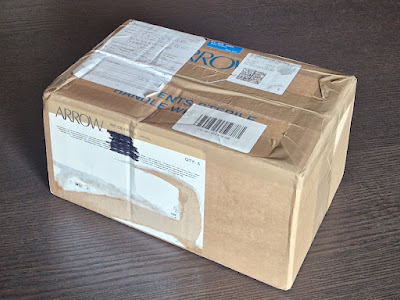 |
| Courtesy to Major Andreas Hauge for making both the illustration and the diorama. They're from the same battle. |
Today it's exactly 85 years since the German invasion of Norway (Operation Weserübung) and the Norwegian Campaign started (8th of April - 10th of June 1940). This battle and campaign is covered at 'Norway's Resistance Museum' located in Oslo, and opened to the public in 1970. The museum doesn't change their exhibitions very often, so it's been pretty much the same since I was a kid. The museum has a row of small dioramas showing the German attack on Norway in 1940, and like the museum exhibits, these 'dioramas' are old and made with what was available on the Norwegian market at the time. -Mostly various Airfix figures and Vinyl toy cars. Despite being 'simple' these dioramas was like a starting point to military modelling for many of us back in the 70ies. The dioramas gives a brief story about the battle of Norway.
The Sinking of the German cruiser '
Blücher' in the early morning of April 9, 1940:
Sola airport (Stavanger) seized by German parachute troops on April 9, 1940:
German units halted at
Midtskogen near Elverum on the night of April 10th in an attempt to capture the King and the Government:
Åndalsnes bombed as British reinforcements are landed on April 20th 1940:
Kristiansund or Molde bombed 1940 by Germans:
A Norwegian unit stood its ground at Vinje svingen in Telemark until May 5, 1940:
Namsos bombed and fired after Allied landings on April 20, 1940:
Bodø wiped out by terror bombing on May 27, 1940:
German positions at Læigastind north of Narvik overrun on May 7, 1940:
Narvik recaptured by Allies on May 28, 1940:
In the final stagees of the Battle of Narvik the Allied forces were suddenly withdrawn to Europe, which left Norwegian forces facing the superior German forces alone and eventually Norway had to capitulate.
The Resistance Museum also shows what the German occupation was like in Norway, about the Norwegians who resisted to the occupation and how they resisted. I'm not going to show it all, but I'm going to show you some of the models telling the history.
The German occupation authorities arrested all teachers that resisted to follow orders and teach Norwegian children the Nazi ideology. There were rumours that the ship was going to be sunken by a German submarine, but it wasn't:
The teachers and all others that resisted to the occupation and participated in illegal activities were imprisoned in German concentration camps. One of the larger ones in Norway was Grini:
But some were sent to KZ-camps in Germany or Poland:
To escape German authorities and imprisonment many Norwegians needed to flee the country. Some of them passed German units and managed to escape to neutral Sweden by foot:
And some Norwegians escaped to Sweden or UK by fising travellers. My
Granduncle was involved in this kind of transport to Sweden:

Many of those who escaped to UK and Sweden recived military training and went back to Norway to train and arm the Resistance movement and to perform sabotage actions:
The Heavy Water production facilities on Vemork, Rjukan was targeted for several sabotage actions to prevent Nazi Germany to develop nuclear weapons:
Fishing-vessels we're not only transporting refugees into safety, but were also used to transport military equipment, weapons and saboteurs back to Norway and supplies to the Resistance movement. They risked to be controlled by German patrol boats when returning to the Norwegian coast:
More often they were playing 'hide and seek' against German patrol boats along the Norwegian coast to avoid German controls:
Norwegian raiding units from SOE were often landed along the Norwegian coast to perform different sabotage operations...
...or raids on industries the German forces benefited from, and therefore was heavily guarded:
The industrial railway of Thamshavn was often targeted for sabotage operations, as it was important for the Germans:
...and when trying to repair locomotives, they were sabotaged at the workshops. It was so critical for the Germans so they needed to bring narrow gauged locomotives from Germany to operate the Thamshavn railway.
Military equipment, weapons and supplies for the Resistance movement was also delivered from UK by air:
Preparations to sink the German ship
SS Donau:
In November 1944 the very offensive communist resistance unit called 'Pelle Gruppa' launched a
major sabotage operations against 2 wharfs in Oslo and destroyed 6 ships, 2 dry docks and one crane. One of those old wharfs is located next to the museum where I work, which now has become a shopping mall:
Blowing up Jørstad railway bridge and derailing a German troop train arriving later on in January 1945. The operation led to firefights between German and American units in Norway in the aftermath:
Operation Polar Bear; The Resistance movement stole 13 vessels from German control and sailed them to safety and out of German reach in neutral Sweden in February 1945:
Towards the end of WW2 in Norway there was a couple of skirmishes between the Norwegian Resistance Movement and German forces assisted by Norwegian SS volunteers. One of them was the
Battle of Haglebu. Due to better weapons the Norwegian Resistance won these firefights and managed to withdraw to safety.
This post was not meant to be a history-lesson, but if you followed this post so far and the links to the different events and operations I added here and there, you probably know more about WW2 in Norway than the average population in Norway now...








































.jpg)








































